How to Optimize Adwords (Google Ads) Campaigns and Pay for Conversions Only
Google Adwords using CPA
When making an online purchase 64% of people click on at least one Google ad. Google Ads (formerly Adwords) makes up 31% of all online advertising, with an average click rate of 1.91% for search ads and 0.35% for display ads. Google has just made it possible to pay for adverts on a Cost Per Acquisition (CPA) basis, so you only pay for conversions.
Advertising on a CPA (Cost Per Acquisition) basis means that you only pay for an ad when someone clicks on it and then completes a purchase. It is a form of pay-per-conversion advertising.
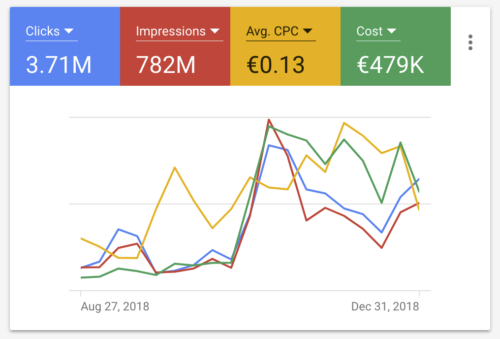
Convertize has had access to this option since 8 August 2018. In fact, since that date, we have spent almost £450 000 (£430,380 to be exact) on pay-per-conversion Adwords campaigns. This post explains how CPA (pay-per-conversion) advertising works and what we have learned whilst using it.
NB. Pay-per-conversion is only available for Display ads, and comes with eligibility criteria. CPA (Cost Per Acquisition) advertising is sometimes described in terms of Cost Per Action.
Optimizing a CPA Adwords Campaign
- How important are Google display ads?
- CPM, CPC, CPA … How different platforms charge for advertising
- How do you set up CPA Cost Per Acquisition Google Ads?
- How do you optimize a CPA Cost Per Acquisition campaign?
- How does the Google Ads CPA algorithm work?
- Conclusions: Google Display Ads with Cost Per Acquisition (Pay-Per-Conversion)
Google is now positioning itself in the performance marketing (CPA) campaign market.
Here is an excerpt from the official statement:
Starting today, you can choose to pay for conversions, rather than clicks, when using Display campaigns. Paying for conversions means you only pay when someone converts on your website or app – and you’ll never pay above your target cost per action (CPA).
Let’s say your target CPA is $10, and you drove 30 conversions over the weekend. You’ll pay exactly $300, with an actual CPA of $10.
You won’t be charged for clicks or impressions.
To understand why this offer is so revolutionary within the world of Display and Native Ads, you need to understand how Google fits into the world of digital advertising.
How important are Google Display ads?
Here are 10 statistics to show you the place of Google in the digital marketing ecosystem, and to help you form a digital marketing strategy.
- Google Adwords represents 31% of all online advertising
- 97% of Google’s total revenue comes from advertising
- Google’s annual revenue increases by an average of 21% per year
- 80% of internet users globally are exposed to Google Adwords display advertising
- Google and Facebook represent 60% of all online advertising
- The average cost per acquisition is £47 for display ad campaigns on Google Adwords
- The average cost per acquisition is £46 for search ad campaigns on Google Adwords
- Amazon is the biggest threat to Google Ads
- Facebook follows Google (by some distance) in total advertising revenue.
- Revenue for Google Display ads is in the order of £5 billion. Neither Taboola not Outbrain reach £1 billion.
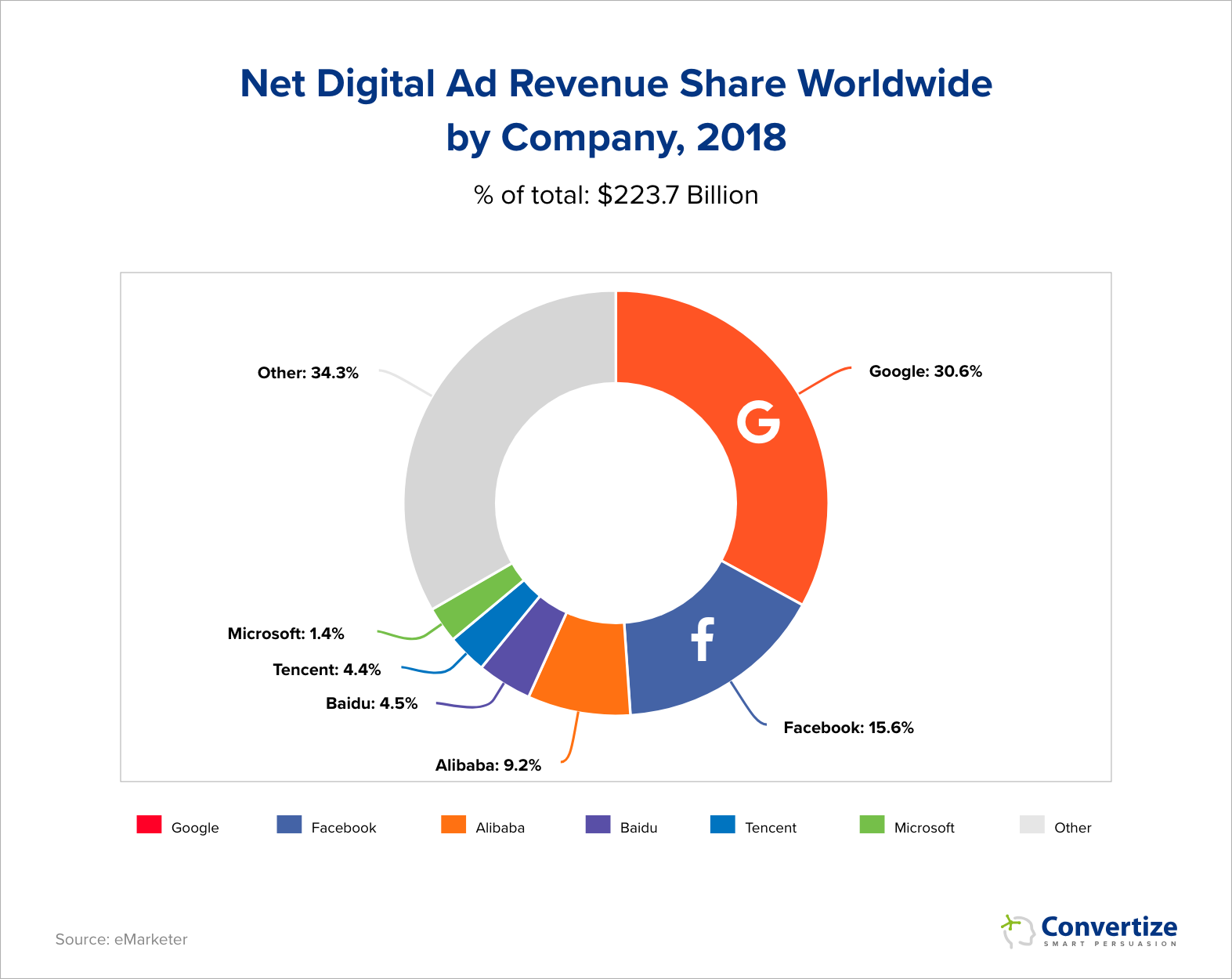
With Google playing such a large part in the global advertising industry, it is easy to see why a change in the way they organise their service might have dramatic consequences.
The opportunity to connect advertising expenditure directly to the number of your conversions is a new and exciting offer. It remains to be seen whether Google’s competitors will be able to respond.
CPM, CPC, CPA … How different platforms charge for advertising
The vast majority of advertising networks run advertising on a CPC or CPM basis. Of the four main networks, Google Ads is the only one to offer a CPA (Cost Per Acquisition) compensation plan.
| Advertising Network | Compensation Method |
|---|---|
| Google Ads | CPC, CPM, CPA |
| Facebook Ads | CPC, CPM |
| Outbrain | CPC |
| Taboola | CPC |
Until recently, paying for advertising campaigns according to the number of conversions you secure was only possible on alternative networks. Affiliate marketing networks such as AWIN, CJ Affiliate and Tradedoubler provided an exclusive performance-related offer. Google Ads (Adwords) now offers advertisers the ability to pay for Display campaigns on a CPA (pay-per-conversions) basis.
There are certain eligibility criteria for access to this CPA pay-per-conversions option. It is not available for:
- Multiple campaigns with a Shared Budget
- Businesses tracking Offline Conversions
- Businesses with a significant Conversion Delay (more than 7 days between click and conversion)
How do you pay for a Cost Per Acquisition Google Adwords campaign?
To use Cost Per Acquisition (pay-per-conversion) display ads, you must meet the following conditions:
- Conversion tracking must be enabled
- You must set a target CPA
- Your Adwords account must have generated more than 100 conversions in the last 30 days.
- The time between the click on the ad and the conversion must be less than 7 days for at least 90% of the conversions recorded.
- Your CPA must be under $/£200
As Google has stated, even if the pay-per-conversion option is displayed in your Google Ads interface, you may still be ineligible to use it.
We experienced several instances of losing access to the CPA system. Some of our sub-accounts still do not have access to the payment option.
However, if you are eligible for pay-per-conversions and have access to the system, make sure that your campaigns have strong traffic and that your sales generate margins in excess of your target CPA.
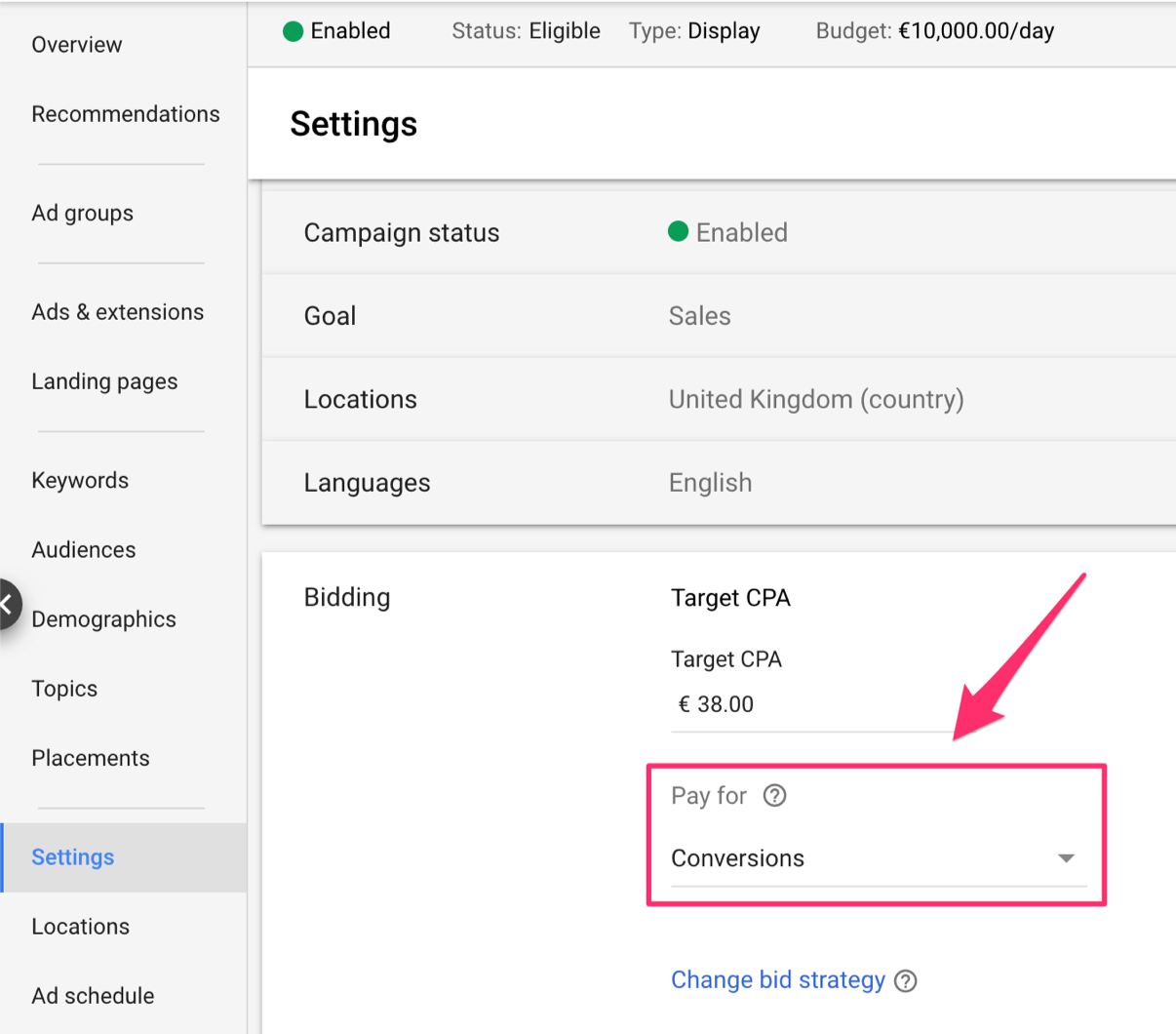
Warning: If you make an error when setting up your payment options (for example, if the conversion pixel disappears), your account may become ineligible. You will receive a notice stating:
“Your account is ineligible to pay for conversions.”
How do you optimize a Cost Per Acquisition (pay-per-conversion) campaign
We’ve spent almost £450,000 on Display Google Ads campaigns since August 8, 2018. Our campaigns targeted 4 European countries:
- United Kingdom
- France
- Germany
- Italy
Here is what we learned:
A campaign running on a CPA basis is not managed like a normal Display campaign. You do not need to optimize it manually because the algorithm does everything for you!
Google’s algorithm will automatically direct traffic across its network to maximize your conversions:
- Do not make exclusion lists
- Do not change your target CPA every day
- Do not disable your ads
- Do not change the targeting settings
You can, of course, add new display ads. However, whilst running an ad, Google takes care of everything.
How does the Google Ads Cost Per Acquisition (Pay-Per-Conversion) algorithm work?
When you launch your Display campaign, the machine-learning system will accumulate data. It does this in an irregular (and sometimes intrusive) way:
- Google Ads tests your campaign at various points. It compares the campaign’s performance with your historical data
- If your Conversion Rate decreases, Google reduces traffic on your campaign
- During the “test” phases your traffic may increase and decrease sharply. You might receive hundreds of visitors in an hour, and then none for several hours.
- Any change in campaign settings can reset the campaign to “Learning” mode
From our experience, the best strategy is to not touch anything. Any change you do make has the potential to disrupt Google’s optimization system.
The ‘learning’ process is an important part of Google’s service. In order to make informed decisions, the Machine Learning algorithm has to accumulate data. If you change your settings, the machine has to re-learn everything. Making constant changes will prevent Google from optimizing your campaign.
- Be patient
- Do not panic
Give Google some time to understand how to optimize your campaign, stay calm when the traffic changes suddenly, and you will see results after a few weeks.
After all, if your campaign is “not good enough for Google”, you will not lose anything. The beauty of the CPA system is that you only pay for conversions.
Conclusions: Google Display ads and Cost Per Acquisition (Pay-Per-Conversion)
It is innovative, even disruptive, for a network the size of Google to offer a CPA option for Display campaigns.
To date, no other major player has tried the same strategy.
Perhaps more surprisingly: it works!
If we compare the situation BEFORE and AFTER we started using the new system, here is what we see:
Our average CPC went from 0.18 € (£0.16) to 0.13 € (£0.12):

Our CTR went from 0.35% to 0.47% and our average position went from 2.9 to 1.1
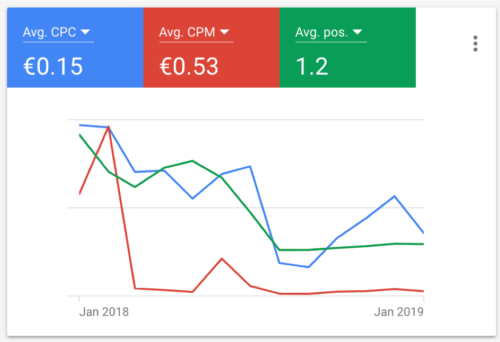
These improvements allowed us to significantly increase our volume, while maintaining our acquisition cost budget.
The results demonstrate Google’s technological edge over other market players
So, what does this mean for the world of digital advertising, Display ads and Native ads?
It seems likely that the volume of Google’s display ads will increase dramatically. There are no longer any barriers for advertisers who did not want to risk breaking their acquisition budgets. The system also makes it possible for anyone to improve the profitability of their Display campaigns.
According to our analysis, only Facebook will be able to match Google with this type of service. In terms of automation, other Native advertising networks are simply jurassic.
If you have experience using Google Ads on a pay-per-conversion basis, leave a comment to tell us about your experience.

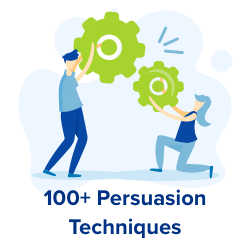


I’m impressed, I have to admit. Rarely do I come across a blog that’s equally educational and engaging, and let me tell you, you have
hit the nail on the head.
Good tips! The most important asset for optimising your Google ads is your historical account data – could you update this post to include data analysis?
Thank you for posting this I was really confused how to have CPA instead of a CPC